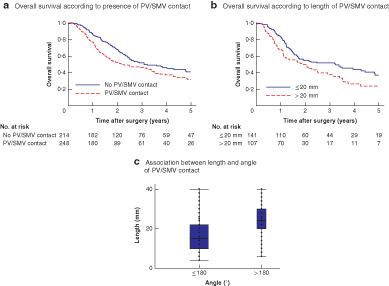当前位置:
X-MOL 学术
›
Br. J. Surg.
›
论文详情
Our official English website, www.x-mol.net, welcomes your
feedback! (Note: you will need to create a separate account there.)
Prognostic role of the length of tumour-vein contact at the portal-superior mesenteric vein in patients having surgery for pancreatic cancer.
British Journal of Surgery ( IF 8.6 ) Pub Date : 2019-10-18 , DOI: 10.1002/bjs.11328 T Imamura 1 , Y Yamamoto 1 , T Sugiura 1 , Y Okamura 1 , T Ito 1 , R Ashida 1 , K Ohgi 1 , A Todaka 2 , A Fukutomi 2 , T Aramaki 3 , K Uesaka 1
British Journal of Surgery ( IF 8.6 ) Pub Date : 2019-10-18 , DOI: 10.1002/bjs.11328 T Imamura 1 , Y Yamamoto 1 , T Sugiura 1 , Y Okamura 1 , T Ito 1 , R Ashida 1 , K Ohgi 1 , A Todaka 2 , A Fukutomi 2 , T Aramaki 3 , K Uesaka 1
Affiliation

|
BACKGROUND
The length of tumour-vein contact between the portal-superior mesenteric vein (PV/SMV) and pancreatic head cancer, and its relationship to prognosis in patients undergoing pancreatic surgery, remains controversial.
METHODS
Patients diagnosed with pancreatic head cancer who were eligible for pancreatoduodenectomy between October 2002 and December 2016 were analysed. The PV/SMV contact was assessed retrospectively on CT. Using the minimum P value approach based on overall survival after surgery, the optimal cut-off value for tumour-vein contact length was identified.
RESULTS
Among 491 patients included, 462 underwent pancreatoduodenectomy for pancreatic head cancer. PV/SMV contact with the tumour was detected on preoperative CT in 248 patients (53·7 per cent). Overall survival of patients with PV/SMV contact exceeding 20 mm was significantly worse than that of patients with a contact length of 20 mm or less (median survival time (MST) 23·3 versus 39·3 months; P = 0·012). Multivariable analysis identified PV/SMV contact longer than 20 mm as an independent predictor of poor survival, whereas PV/SMV contact greater than 180° was not a predictive factor. Among patients with a PV/SMV contact length exceeding 20 mm on pretreatment CT, those receiving neoadjuvant therapy had significantly better overall survival than patients who had upfront surgery (MST not reached versus 21·6 months; P = 0·002).
CONCLUSION
The length of PV/SMV contact predicts survival, and may be used to suggest a role for neoadjuvant therapy to improve prognosis.
ANTECEDENTES
El valor pronóstico de la longitud del contacto del tumor de la cabeza pancreática con las venas porta y mesentérica superior (portal-superior mesenteric vein, PV/SMV) en los pacientes sometidos a cirugía pancreática sigue siendo un tema controvertido. MÉTODOS: Se analizaron los pacientes diagnosticados de un cáncer de la cabeza pancreática a los que se realizó una duodenopancreatectomía cefálica entre octubre de 2002 y diciembre de 2016. El contacto tumoral con la PV/SMV se evaluó de forma retrospectiva mediante tomografía computarizada (TC). Se identificó el valor de corte óptimo para la longitud del contacto tumoral con la PV/SMV, utilizando el valor mínimo de la P basado en la supervivencia global (overall survival, OS) después de la cirugía.
RESULTADOS
De 491 pacientes incluidos, en 462 pacientes se realizó una duodenopancreatectomía cefálica por cáncer de la cabeza de páncreas. En la TC preoperatoria, se detectó contacto tumoral con la PV/SMV en 248 (53,7%) pacientes. La OS de los pacientes en los que el contacto del tumor con la PV/SMV fue > 20 mm fue significativamente peor que en aquellos cuyo contacto fue ≤ 20 mm (mediana de supervivencia (median survival time, MST) 23,3 versus 39,3 meses; P = 0,012). En un análisis multivariado se identificó el contacto tumoral-PV/SMV > 20 mm como un factor independiente predictor de mala supervivencia, pero el contacto tumor-PV/SMV > 180° no fue un factor pronóstico. En los pacientes en los que el contacto tumor-PV/SMV fue > 20 mm en el TC preoperatorio, la OS en aquellos que recibieron tratamiento neoadyuvante fue significativamente mejor en comparación con los pacientes tratados directamente con cirugía (MST, no alcanzada versus 21,6 meses, P = 0,002). Conclusión La longitud del contacto tumoral con la PV/SMV predice la supervivencia, por lo cual dicha longitud podría jugar un papel en la indicación de tratamiento neoadyuvante para mejorar el pronóstico.
中文翻译:

胰腺癌手术患者的肿瘤静脉接触长度在肠系膜上静脉的预后作用。
背景技术门静脉上肠系膜静脉(PV / SMV)与胰腺头癌之间的肿瘤静脉接触的长度,以及其与接受胰腺手术的患者的预后的关系仍然存在争议。方法分析2002年10月至2016年12月之间符合胰十二指肠切除术资格的诊断为胰头癌的患者。通过CT回顾性评估PV / SMV接触。使用基于手术后总体生存率的最小P值方法,确定了肿瘤-静脉接触长度的最佳临界值。结果在491例患者中,有462例因胰头癌接受了胰十二指肠切除术。在248例患者中,术前CT检测到PV / SMV与肿瘤的接触(53·7%)。PV / SMV接触超过20 mm的患者的总生存率显着低于接触长度不超过20 mm的患者(中位生存时间(MST)23·3对39·3个月; P = 0·012) 。多变量分析表明,PV / SMV接触时间长于20 mm是生存不良的独立预测因素,而PV / SMV接触时间长于180°并不是预测因素。在治疗前CT上PV / SMV接触长度超过20 mm的患者中,接受新辅助疗法的患者的总生存期显着高于接受前期手术的患者(未达到MST的时间为21·6个月; P = 0·002)。结论PV / SMV接触的时间长短可预测生存,并可用于暗示新辅助治疗可改善预后。肠上皮癌的前缘,腹腔和肠系膜上腔静脉(PV / SMV上腔门)Métodos:从2002年开始到2016年从头到尾进行全科医生诊断,从2016年开始到2016年从两方面开始。 。全球/整体存活率最高的生存/生存状况(全球生存率)。RESULTADOS De 491 pacientes incluidos,zh-CN 462在实现双重造就的过程中,实现了全部权利。术前进行TC,可检测到PV / SMV引起的接触性肿瘤,共248(53,7%)名患者。PV / SMV致癌物> 20 mm致癌物,≤20 mm(超级存活中值(中位生存时间,MST)23,3 vs 39, 3毫秒; P = 0,012)。肝癌的多变量联合鉴定-PV / SMV> 20毫米,是超级生存的独立预测因子,接触性肿瘤-PV / SMV> 180°,无因果关系。接触性肿瘤-PV / SMV因子> 20 mm en TC术前 易受攻击的重大事故发生的重大原因(MST,无alcanzada与21,6 meses,P = 0,002)。纵断面是PV / SMV的慢性肿瘤,这是由于纵断面和纵断面的关系。
更新日期:2019-10-18
中文翻译:

胰腺癌手术患者的肿瘤静脉接触长度在肠系膜上静脉的预后作用。
背景技术门静脉上肠系膜静脉(PV / SMV)与胰腺头癌之间的肿瘤静脉接触的长度,以及其与接受胰腺手术的患者的预后的关系仍然存在争议。方法分析2002年10月至2016年12月之间符合胰十二指肠切除术资格的诊断为胰头癌的患者。通过CT回顾性评估PV / SMV接触。使用基于手术后总体生存率的最小P值方法,确定了肿瘤-静脉接触长度的最佳临界值。结果在491例患者中,有462例因胰头癌接受了胰十二指肠切除术。在248例患者中,术前CT检测到PV / SMV与肿瘤的接触(53·7%)。PV / SMV接触超过20 mm的患者的总生存率显着低于接触长度不超过20 mm的患者(中位生存时间(MST)23·3对39·3个月; P = 0·012) 。多变量分析表明,PV / SMV接触时间长于20 mm是生存不良的独立预测因素,而PV / SMV接触时间长于180°并不是预测因素。在治疗前CT上PV / SMV接触长度超过20 mm的患者中,接受新辅助疗法的患者的总生存期显着高于接受前期手术的患者(未达到MST的时间为21·6个月; P = 0·002)。结论PV / SMV接触的时间长短可预测生存,并可用于暗示新辅助治疗可改善预后。肠上皮癌的前缘,腹腔和肠系膜上腔静脉(PV / SMV上腔门)Métodos:从2002年开始到2016年从头到尾进行全科医生诊断,从2016年开始到2016年从两方面开始。 。全球/整体存活率最高的生存/生存状况(全球生存率)。RESULTADOS De 491 pacientes incluidos,zh-CN 462在实现双重造就的过程中,实现了全部权利。术前进行TC,可检测到PV / SMV引起的接触性肿瘤,共248(53,7%)名患者。PV / SMV致癌物> 20 mm致癌物,≤20 mm(超级存活中值(中位生存时间,MST)23,3 vs 39, 3毫秒; P = 0,012)。肝癌的多变量联合鉴定-PV / SMV> 20毫米,是超级生存的独立预测因子,接触性肿瘤-PV / SMV> 180°,无因果关系。接触性肿瘤-PV / SMV因子> 20 mm en TC术前 易受攻击的重大事故发生的重大原因(MST,无alcanzada与21,6 meses,P = 0,002)。纵断面是PV / SMV的慢性肿瘤,这是由于纵断面和纵断面的关系。











































 京公网安备 11010802027423号
京公网安备 11010802027423号